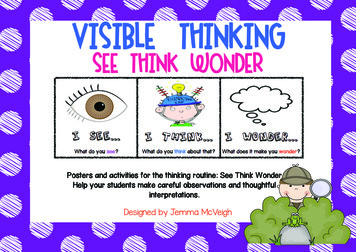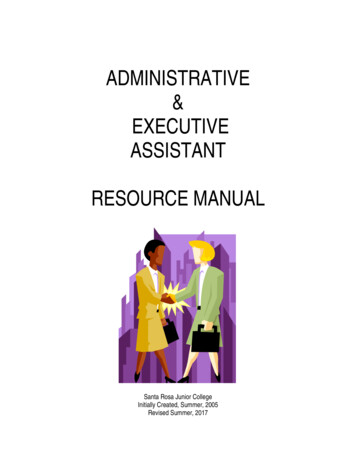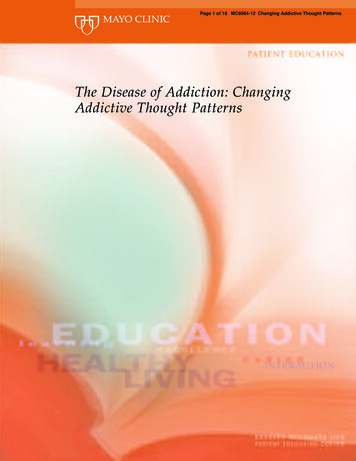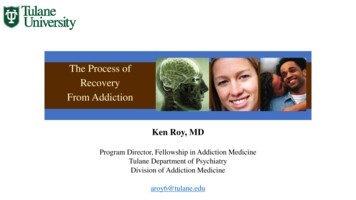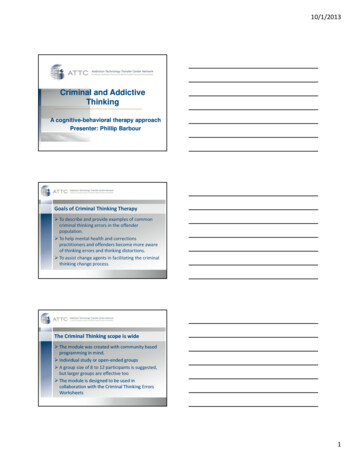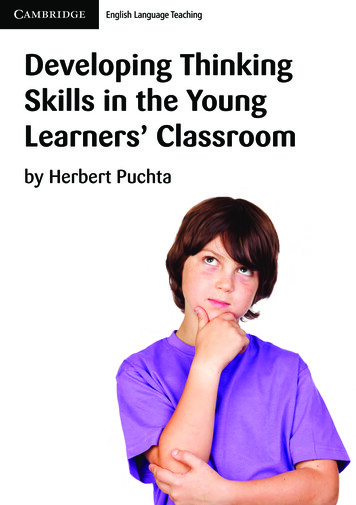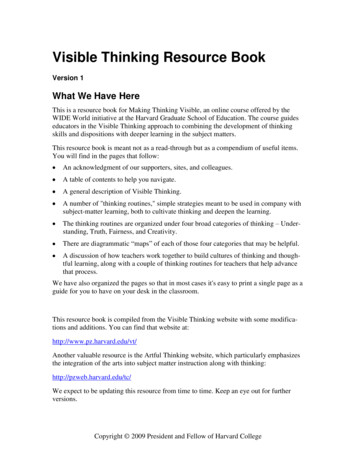
Transcription
Visible Thinking Resource BookVersion 1What We Have HereThis is a resource book for Making Thinking Visible, an online course offered by theWIDE World initiative at the Harvard Graduate School of Education. The course guideseducators in the Visible Thinking approach to combining the development of thinkingskills and dispositions with deeper learning in the subject matters.This resource book is meant not as a read-through but as a compendium of useful items.You will find in the pages that follow:An acknowledgment of our supporters, sites, and colleagues.A table of contents to help you navigate.A general description of Visible Thinking.A number of "thinking routines," simple strategies meant to be used in company withsubject-matter learning, both to cultivate thinking and deepen the learning.The thinking routines are organized under four broad categories of thinking – Understanding, Truth, Fairness, and Creativity.There are diagrammatic “maps” of each of those four categories that may be helpful.A discussion of how teachers work together to build cultures of thinking and thoughtful learning, along with a couple of thinking routines for teachers that help advancethat process.We have also organized the pages so that in most cases it's easy to print a single page as aguide for you to have on your desk in the classroom.This resource book is compiled from the Visible Thinking website with some modifications and additions. You can find that website at:http://www.pz.harvard.edu/vt/Another valuable resource is the Artful Thinking website, which particularly emphasizesthe integration of the arts into subject matter instruction along with thinking:http://pzweb.harvard.edu/tc/We expect to be updating this resource from time to time. Keep an eye out for furtherversions.Copyright 2009 President and Fellow of Harvard College
Visible Thinking Resource Book2AcknowledgmentsThe development of the Visible Thinking initiative spans a number of years and continues today. The original research base toward what became Visible Thinking began withsupport from the Spencer Foundation and years later continued with support from theJohn D. and Catherine T. MacArthur Foundation. The development of the Visible Thinking framework itself received support from Peder Wallenberg and the Stiftelsen CarpeVitam Foundation with intensive site-based work at Lemshaga Akademi in Sweden. Thework continued at the Traverse City, Michigan School System in the version ArtfulThinking, funded in part by a U.S Department of Education Arts in Education Model Development & Dissemination Grant; and at Bialik College in Melbourne, Australia, in theversion Cultures of Thinking with support from Bialik College itself and the Abe and Vera Dorevitch Foundation. The development of the online course this resource serves ispart of the activities of the WIDE World initiative, supported by Al and Kate Merck.All of this work has been conducted as part of the activities of Project Zero at the Harvard Graduate School of Education. The principal researchers and developers involvedhave been David Perkins, Ron Ritchhart, and Shari Tishman. We have collaboratedclosely with several key individuals at Project Zero and the development sites mentionedabove, and have worked with many school leaders and teachers in several parts of theworld who have embraced these ideas, helped to bring them alive in their own settings,and contributed to their advancement. Karin Morrison, the instructor for the WIDE Worldcourse on Making Thinking Visible, has long been a partner in this work at Bialik College in Melbourne.We are immensely grateful for the confidence and commitment of our supporters, colleagues, and friends.
Visible Thinking Resource Book3Table of ContentsA Brief Introduction to Visible Thinking . 5A bit about our research . 6Introduction to Thinking Routines . 8A Compendium of Thinking Routines . 10Understanding Routines . 12Connect Extend Challenge: Connecting new ideas to prior knowledge . 13Explanation Game: Exploring causal understanding . 15Headlines: Capturing essence . 17See Think Wonder: Exploring works of art and other interesting things . 19I Used to Think, Now I Think: Reflecting on how and why our thinking has changed 21Question Starts: Creating thought-provoking questions . 22Think Pair Share: Active reasoning and explanation . 25Think Puzzle Explore: Setting the stage for deeper inquiry . 32What Makes You Say That: Interpretation with justification . 393-2-1 Bridge: Activating prior knowledge and making connections . 49Color, Symbol, Image: Distilling the essence of ideas non-verbally. 50Generate, Sort, Connect, Elaborate: Organizing one's understanding of a topic throughconcept mapping . 51Peel The Fruit: A Map for Tracking and Guiding Understanding . 52Truth Routines . 55Claim Support Question: Exploring truth claims. 56Hot Spots: Noticing when truth is at issue . 59Stop Look Listen: Clarifying claims and sources . 64True for Who?: Exploring truth claims from different perspectives . 66Tug for Truth: Exploring evidence on multiple sides of a case . 69Compass Points: Examining propositions. 72Red Light, Yellow Light for Truth: Focusing students on signs of puzzles of truth . 74Fairness Routines . 76Circle of Viewpoints: Exploring diverse perspectives. 77Here Now / There Then: Considering presentist attitudes and judgments . 87Making It Fair: Now, Then, Later: Finding actions . 92Reporter's Notebook: Separating fact and feeling . 94Tug of War: Exploring the complexity of fairness dilemmas. 98Creativity Routines . 102Creative Questions: Generating and transforming questions. 110Does It Fit? Thinking creatively about options. 113Options Diamond: Exploring the tensions of decision making . 116Options Explosion: Creative decision making. 118Step Inside – Perceive, Know about, Care about: Getting inside viewpoints. 119Thinking “Ideals” . 121Maps for the Thinking Ideals . 121Map of the Understanding Ideal . 122Map of the Truth Ideal . 123Map of the Fairness Ideal . 124
Visible Thinking Resource Book4Map of the Creativity Ideal . 125School-Wide Culture of Thinking . 126Introduction and Overview . 126Study Group Materials . 127Me You Space Time – The MYST Routine: A routine to help teachers prepare andreflect on making thinking visible . 129Looking At Students' Thinking (LAST) Protocol: Collaboratively looking at students‟thinking . 130Study Group Pictures of Practice . 132Tips and Suggestions . 141Institutional Structure & Supports . 141
Visible Thinking Resource Book5A Brief Introduction to Visible ThinkingEvery committed educator wants better learning and more thoughtful students. VisibleThinking is a way of helping to achieve that without a separate „thinking skills' course orfixed lessons.Visible Thinking is a broad and flexible framework for enriching classroom learning inthe content areas and fostering students' intellectual development at the same time. Hereare some of its key goals:Deeper understanding of contentGreater motivation for learningDevelopment of learners' thinking and learning abilities.Development of learners' attitudes toward thinking and learning and their alertness to opportunities for thinking and learning (the "dispositional" side of thinking).A shift in classroom culture toward a community of enthusiastically engagedthinkers and learners.Toward achieving these goals, VisibleThinking involves several practicesand resources. Teachers are invited touse with their students a number of"thinking routines" – simple protocolsfor exploring ideas – around whatevertopics are important, say fractionsarithmetic, the Industrial Revolution,World War II, the meaning of a poem,the nature of democracy. VisibleThinking includes attention to fourbig categories of thinking – Understanding, Truth, Fairness, and Creativity. Sometimes we call them "thinking ideals" because they are all ideal aspirations forgood thinking and learning. And of course there are other thinking ideals as well. VisibleThinking emphasizes several ways of making students' thinking visible to themselves andone another, so that they can improve it.The idea of visible thinking helps to make concrete what a thoughtful classroom mightlook like. At any moment, we can ask, "Is thinking visible here? Are students explainingthings to one another? Are students offering creative ideas? Are they, and I as their teacher, using the language of thinking? Is there a brainstorm about alternative interpretationson the wall? Are students debating a plan?"
Visible Thinking Resource Book6When the answers to questions like these are consistently yes, students are more likely toshow interest and commitment as learning unfolds in the classroom. They find moremeaning in the subject matters and more meaningful connections between school andeveryday life. They begin to display the sorts of attitudes toward thinking and learningwe would most like to see in young learners – not closed-minded but open-minded, notbored but curious, neither gullible nor sweepingly negative but appropriately skeptical,not satisfied with "just the facts" but wanting to understand.A bit about our researchVisible Thinking is the product of a number of years of research concerning children'sthinking and learning, along with a sustained research and development process in classrooms.One important finding was that skills and abilities are not enough. They are important ofcourse, but alertness to situations that call for thinking and positive attitudes towardthinking and learning are tremendously important as well. Often, we found, children (andadults) think in shallow ways not for lack of ability to think more deeply but because theysimply do not notice the opportunity or do not care. To put it all together, we say that really good thinking involves abilities, attitudes, and alertness, all three at once. Technically this is called a dispositional view of thinking. Visible Thinking is designed to foster allthree.Another important result of this research concerns the practical functionality of the Visible Thinking approach – the thinking routines, the thinking ideals, and other elements.All these were developed in classroom contexts and have been revised and revised againto ensure workability, accessibility, rich thinking results from the activities, and teacherand student engagement.Why Make Thinking Visible?The central idea ofVisible Thinkingis very simple:making thinkingvisible.We learn bestwhat we can seeand hear ("visiblethinking" means generally available to the senses,perceptually accessible so to speak, not just what youcan see with your eyes). We watch, we listen, we imitate, we adapt what we find to our own styles andinterests, we build from there. Now imagine learningto dance when the dancers around you are all invisible. Imagine learning a sport when the players who
Visible Thinking Resource Book7already know the game can't be seen.Strange as it seems, something close to it happens all the time inone very important area of learning: learning to think, whichincludes learning to learn. Thinking is pretty much invisible. Tobe sure, sometimes people explain the thoughts behind a particular conclusion, but often they do not. Mostly, thinking happensunder the hood, within the marvelous engine of our mind-brain.Visible Thinking includes a number of ways of making students'thinking visible to themselves, to their peers, and to the teacher,so they get more engaged by it and come to manage it better forlearning and other purposes.When thinking is visible in classrooms, students are in a position to be more metacognitive,to think about their thinking. When thinking is visible, it becomes clear that school is not about memorizing content butexploring ideas. Teachers benefit when they can see students' thinking because misconceptions, prior knowledge,reasoning ability, and degrees of understanding are morelikely to be uncovered. Teachers can then address thesechallenges and extend students' thinking by starting fromwhere they are.
Visible Thinking Resource Book8Introduction to Thinking RoutinesRoutines EverywhereRoutines exist in all classrooms; they are the patterns by which we operate and go aboutthe job of learning and working together in a classroom environment. A routine can bethought of as any procedure, process, or pattern of action that is used repeatedly to manage and facilitate the accomplishment of specific goals or tasks. Classrooms have routines that serve to manage student behavior and interactions, to organizing the work oflearning, and to establish rules for communication and discourse. Classrooms also haveroutines that structure the way students go about the process of learning. These learningroutines can be simple structures, such as reading from a text and answering the questionsat the end of the chapter, or they may be designed to promote students' thinking, such asasking students what they know, what they want to know, and what they have learned aspart of a unit of study.The Idea of Thinking RoutinesVisible Thinking makes extensive use of learning routines that are thinking rich. Theseroutines are simple structures, for example a set of questions or a short sequence of steps,that can be used across various grade levels and content. What makes them routines, versus merely strategies, is that they get used over and over again in the classroom so thatthey become part of the fabric of classroom' culture. The routines become the ways inwhich students go about the process of learning.Of course, thinking routines are also meant to be useful beyond the classroom – for understanding everyday situations or ideas from the newspaper or TV, viewing sources ofinformation critically, planning just about anything, making decisions, dealing with interpersonal relationships, considering moral problems, addressing situations inventively,and indeed all the circumstances where thinking proves so fundamental to human endeavor. Students and parents often spontaneously report applications outside of school,strong encouragement for our endeavor!Thinking routines form the core of the Visible Thinking program. What makes these routines work to promote the development of a students thinking and the classroom cultureare that each routine:Is goal oriented in that it targets specific types of thinkingGets used over and over again in the classroomConsists of only a few stepsIs easy to learn and teachIs easy to support when students are engaged in the routine
Visible Thinking Resource Book9Can be used across a variety of contextCan be used by the group or by the individualRoutines are really just patterns of action that can be integrated and used in a variety ofcontexts. You might even use more than one routine in teaching a single lesson. Thus,you shouldn't think about the routine as taking time away from anything else you aredoing, they should actually enhance what you are trying to do in the classroom.Focus on Integration with Existing ContentBecause of their simple nature, the routines do not need to be taught separately. They cansimply be used right away as a means of investigating and working with current subjectmatter, whatever it happens to be.If you have a topic and routine in mind, take a minute to try out the routine on the topicyourself, just to check that it's generative. That said, often teachers employ routines spontaneously in "teachable moments," and that generally works out well too. Sometimeswhen teachers first use a routine with their students, they do so with a convenient topicthat may not be a regular part of students' study, just to get students used to the routine.For example, the "What makes you say that?" routine might be introduced with an engaging picture or photograph, though later a teacher might want to use it with a poem, artifact, or scientific experiment from the curriculum. But many teachers just jump in with acontent-related topic. With all of the routines, teachers will need to think about what topics are most appropriate for their introduction and continued use.Favorite RoutinesHere are several routines that target different types of thinking. These routines are easy toget started with and are commonly found in Visible Thinking teachers' toolkits. Youmight want to get started with one of these routines. You can find them through the tableof contents.What Makes You Say That? Interpretation with justification routineThink Puzzle Explore A routine that sets the stage for deeper inquiryThink Pair Share A routine for active reasoning and explanationCircle of Viewpoints A routine for exploring diverse perspectivesI Used to Think. Now I think. A routine for reflecting on how and why our thinkinghas changedSee Think Wonder A routine for exploring works of art and otherinteresting thingsCompass Points A routine for examining propositionsHeadlines A routine for capturing the essence
Visible Thinking Resource Book10Claim Support Question A routine for exploring truth claimsTug for Truth A routine for exploring evidence on multiple sides of a caseStep Inside A routine for getting inside viewpointsA Compendium of Thinking RoutinesThinking routines in four categoriesBelow you will find a number of thinking routines, organized under the four categoriesUnderstanding, Truth, Fairness, and Creativity – four “thinking ideals.” Understandingroutines particularly serve the understanding of ideas and objects. There are quite a fewof these, because Understanding has proven to be particularly resonant with the needs ofclassroom teaching and learning. Truth routines address claims and their soundness anddifferent perspectives on claims. Fairness routines address issues of fairness, justice, equity, and the like. Creativity routines concern functioning creatively and recognizing thecreative aspects of ideas and objects.But of course it's not that neat! Almost any routine, whether it's grouped here as an understanding routine or not, can serve understanding – we understand things better by appraising their truth, examining their fairness, and adopting a creative stance toward them.Many routines might be classified in more than one way. And of course, we could havemore than four thinking ideals. Please take the grouping below as a grouping of convenience and feel free to use any routine for whatever purpose it seems to be suited.The profile of a routineThe profile of a routine includes:A concise characterization, beginning with a table that summarizes the steps of theroutine and going on to describe the purpose of the routine, when it might be used,and how to get started. When possible, this appears on a single page for easy printingand taking to class.Often, a Picture of Practice illustrating the routine in action. These generally includetext and photos of student work. In a few cases there are videos in the video collection for Making Thinking Visible.Often, a brief Connections and Extensions section comments on how to stretch theroutine.However, sometimes we don't have one or another of the last two elements. This does notmean that the routine in question has seen any less use or is less valuable. It's an accidentof circumstances: how recently the routine was created and whether anyone got around toconstructing Pictures of Practice or Connections and Extensions.
Visible Thinking Resource Book11Make up your own by all means!Teachers commonly not only use these routines but make up their own and share them.Indeed, some of the routines below were adapted from various sources and teachers. Feelfree to do this. It's a creative enterprise. There is no final official and "right" set of thinking routines. In the Video Collection, the video of The Thinking Keys by Stephanie Martin, Kindergarten, illustrates a teacher-developed routine.
Visible Thinking Resource Book12Understanding RoutinesConnect Extend Challenge A routine for connecting new ideas to prior knowledgeExplanation Game A routine for exploring causal understanding*Headlines A routine for capturing essence*See Think Wonder A routine for exploring works of art and other interesting things*I Used to Think, Now I Think A routine for reflecting on how and why our thinking haschangedQuestion Starts A routine for creating thought-provoking questions*Think Pair Share A routine for active reasoning and explanation*Think Puzzle Explore A routine that sets the stage for deeper inquiry*What makes you say that? A routine for interpretation with justification3-2-1 Bridge A routine for activating prior knowledge and making connectionsColor, Symbol, Image A routine for distilling the essence of ideas non-verballyGenerate, Sort, Connect, Elaborate A routine for organizing one's understanding of atopic through concept mappingPeel the Fruit A map for tracking and guiding understanding*Consider starting with one of these routines
Visible Thinking Resource Book13Connect Extend Challenge: Connecting new ideas to prior knowledgeCONNECT:How are the ideas and information presentedCONNECTED to what youalready knew?EXTEND:What new ideas did you getthat EXTENDED or pushedyour thinking in new directions?CHALLENGE: What is stillCHALLENGING or confusing for you to get your mindaround? What questions,wonderings or puzzles doyou now have?Purpose: What kind of thinking does this routine encourage?The routine helps students make connections between new ideas and prior knowledge. Italso encourages them to take stock of ongoing questions, puzzles and difficulties as theyreflect on what they are learning.Application: When and Where can it be used?The natural place to use the Connect-Extend-Challenge routine is after students havelearned something new. It doesn't matter how much they have learned – it can be a lesson's worth, or a unit's worth. The routine is broadly applicable: Use it after students haveexplored a work of art, or anything else in the curriculum. Try it as a reflection during alesson, after a longer project, or when completing a unit of study. Try using it afteranother routine!Launch: What are some tips for starting and using this routine?This routine works well with the whole class, in small groups or individually. Keep a visible record of students' ideas. If you are working in a group, ask students to share some oftheir thoughts and collect a list of ideas in each of the three categories Or have studentswrite their individual responses on Post-it notes and add them to a class chart. Keep students' visible thinking alive over time: Continually add new ideas to the lists and revisitthe ideas and questions on the chart as students' understanding around a topic develops.
Visible Thinking Resource Book14Connect Extend Challenge: Pictures of PracticeLook at the videos collection to see: Connect Extend Challenge: Susan Loban,Grade 5, Migration, from the International School of AmsterdamSusan Loban's class has been studying migration for eight weeks and students have madeart installations that reflect their understanding of the topic so far. They use the ConnectExtend Challenge routine to share the projects and discuss the thinking be. The routinehelps the students make connections to their original ideas about migration and thinkabout how their ideas have changed, or extended. It helps to uncover some questions andpuzzles about the topic that are still challenging students, and that can be investigatedduring the final weeks of their study.Look at the videos collection to see: Connect Extend Challenge: Mark Church,Grade 6, Human origins, from the International School of AmsterdamMark Church's social studies class recently viewed a video as part of their study on theorigins of human society. Students used the Connect Extend Challenge routine to shareand discuss their ideas about the video. In small groups they identified connections tothings they had already been thinking about and discussed how their ideas about earlyhumans have changed, or extended, in new directions. The routine helps to uncover somequestions and puzzles about the topic that are still challenging or puzzling students. In thefinal weeks of their study, the class investigated these issues.
Visible Thinking Resource Book15Explanation Game: Exploring causal understandingThe routine focuses first on identifying something interesting about an object or idea:"I notice that."And then following that observation with thequestion:"Why is it that way?"or"Why did it happen that way?"Purpose: What kind of thinking does this routine encourage?This is a routine for understanding why something is the way it is. This routine can get ateither causal explanation or explanation in terms of purposes or both.Application: When and Where can it be used?You can apply it to almost anything: a pencil, cell phones, forms of government, historical documents, and events. Students can work in pairs or groups of larger size, even awhole class. The explanation game can also be used solo. The first time the routine isused, the teacher may need to take an active role in scaffolding the conversation andmodeling how to ask questions of explanation and clarification if others. Over time, students can begin to emulate the conversational moves and questioning they have seenmodeled.Launch: What are some tips for starting and using this routine?Begin with something "on the table" – an object like a cup or a compass, a document likea poem, a picture, an historical event, a scientific theory, etc. The first person (this mightbe the teacher initially) points out an interesting feature of the object: "I notice that.That's interesting. Why is it that way? or "Why did it happen that way?" (or some similarwhy question). The other people in the group try to answer the question or at least to propose possible explanations and reasons. As these students share their ideas, the personasking the original question follows up by asking, "What makes you think so?" Thegroup works together to build explanations rather than merely deferring to an outsidesource, the teacher or a textbook, to provide an answer.Student questions and explanations become visible to the class as they are shared. Responses to the routine also can be written down and recorded so that there is a class list ofevolving ideas. A few key issues or puzzles might then be chosen for further investigations. A conversation could also be recorded as a chart with four columns representingthe key structures of the conversation: 1) the Observation that is initially made, 2) theQuestion that comes out of that observation, 3) the various Explanations/Hypotheses thatthe rest of group puts forth, 4) the Reasons /Justifications that are given in support of theexplanations.
Visible
Visible Thinking Resource Book 5 A Brief Introduction to Visible Thinking Every committed educator wants better learning and more thoughtful students. Visible Thinking is a way of helping to achieve that without a separate „



